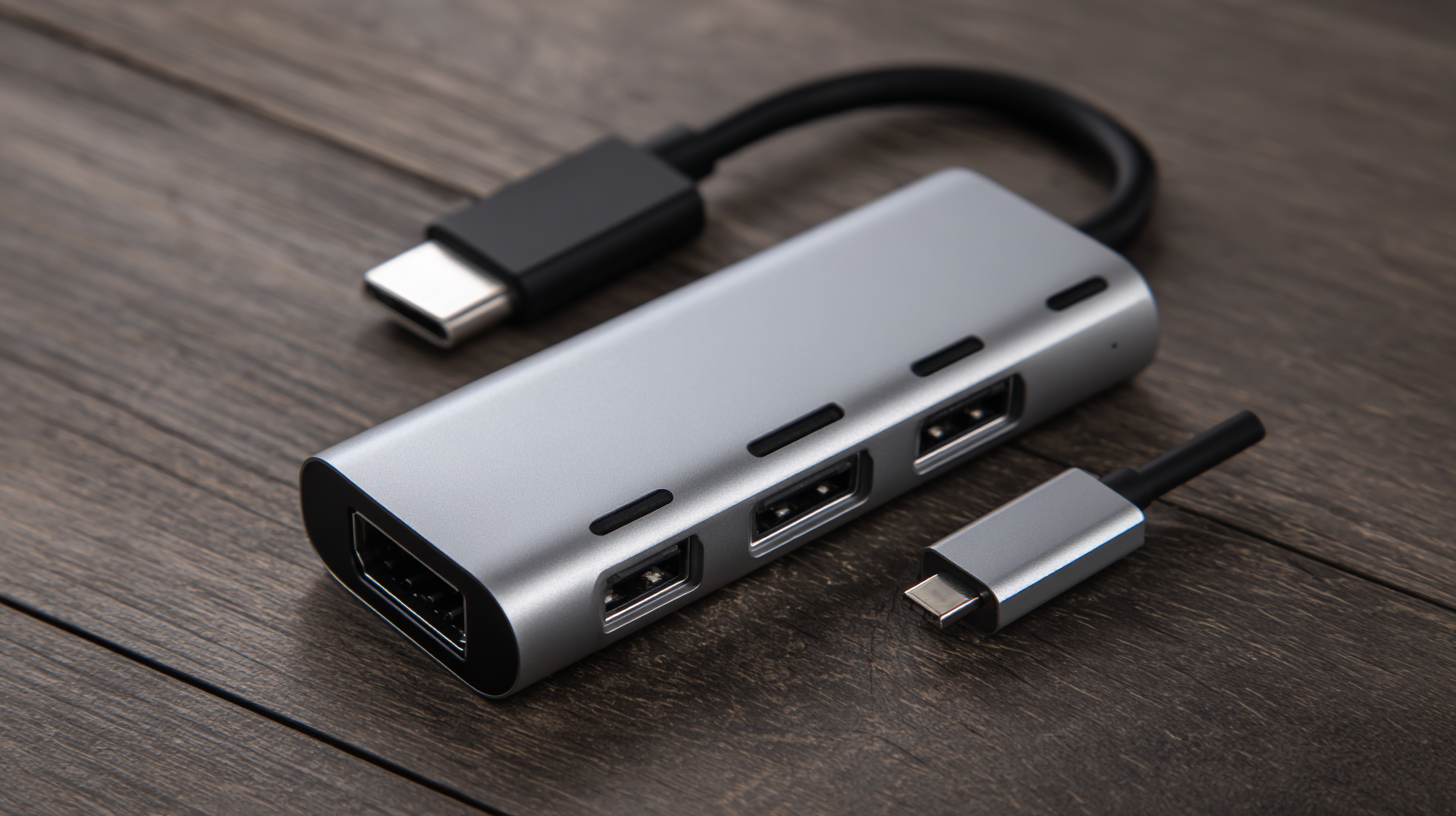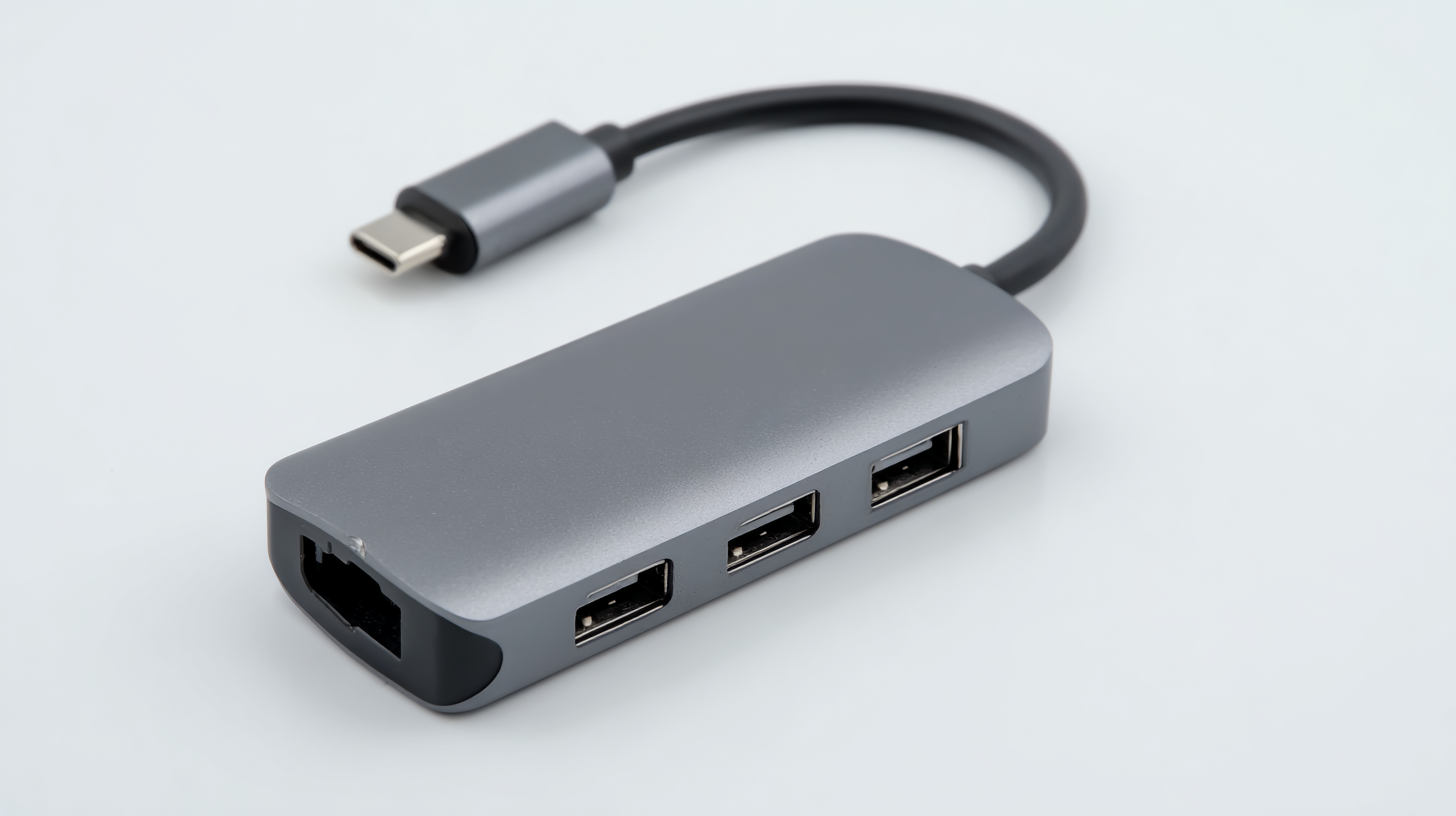
-
Home
-
Products
-
About Us
-
OEM&ODM
-
News
-
Contact Us
Inquiry
Form loading...

As the world increasingly shifts towards USB Type-C technology, the demand for versatile and efficient USB Type C Hub Adapters has surged. According to a recent report by Statista, the global USB Type-C market is expected to grow significantly, with a projected compound annual growth rate (CAGR) of over 20% from 2021 to 2026. This growth reflects the widespread adoption of devices featuring USB Type-C ports, including laptops, smartphones, and tablets. However, users often encounter challenges, such as compatibility issues and inadequate power delivery options when utilizing standard USB Type C Hub Adapters. This blog explores unique alternatives that address these problems, offering innovative solutions designed to enhance connectivity and user experience in an increasingly digital world.

By examining the limitations of conventional adapters and highlighting creative approaches, we aim to empower consumers with informed choices in their tech accessories.
USB Type-C hub adapters are revolutionizing the way we connect devices, providing numerous advantages over traditional adapters. One of the most significant benefits is the ability to support a multitude of connections through a single port. Unlike older USB standards, which often limited users to one or two functionalities at a time, USB Type-C hubs can seamlessly integrate various ports, including HDMI, Ethernet, USB-A, and even SD card readers. This versatility not only reduces clutter but also enhances productivity, allowing users to connect multiple devices simultaneously without the hassle of juggling different adapters.

Moreover, USB Type-C hubs are designed with speed and efficiency in mind. They can offer faster data transfer rates and improved power delivery, making them ideal for tasks that require quick file transfers or charging multiple devices. For instance, many USB Type-C hubs feature Power Delivery (PD) technology, enabling users to charge their laptops while also connecting peripherals, which is a game-changer for those on the go. The sleek, reversible design of USB Type-C connectors further simplifies usage, eliminating the frustration often associated with conventional USB ports. Overall, USB Type-C hub adapters not only streamline connectivity but also enhance overall device performance, making them a worthy upgrade for any tech-savvy individual.
The demand for USB Type-C hubs has skyrocketed, driven by the increasing prevalence of devices equipped with USB-C ports. A report by Market Research Future predicts that the global USB hub market will grow at a CAGR of 6.3% from 2021 to 2026, emphasizing the need for innovative solutions. When exploring modern USB Type-C hubs, users should look for essential features that enhance functionality and convenience.
One notable trend is the integration of multi-port options. Innovative hubs now offer a mix of HDMI, Ethernet, and USB-A ports alongside USB-C, allowing users to connect various peripherals simultaneously. A study from Statista highlights that 75% of consumers prioritize ease of connectivity when selecting tech accessories. Furthermore, power delivery (PD) support is becoming increasingly critical, enabling users to charge laptops while using their hubs. According to recent data, nearly 60% of users consider PD capacity a significant factor in purchasing decisions, showcasing the importance of robust power management features in these devices.
Additional features, such as built-in security measures and compact designs, are also gaining traction. Reports indicate that more than 50% of users prefer hubs with integrated security protocols to safeguard data during file transfers. Moreover, as remote work becomes more prevalent, lightweight and portable designs have become essential for on-the-go professionals. The right blend of these innovative features will ensure that modern USB Type-C hubs meet the diverse needs of today’s tech-savvy users.
| Feature | Description | Benefits |
|---|---|---|
| Multiple Ports | Includes various ports like HDMI, USB-A, and Ethernet. | Enhances connectivity options for different devices. |
| Fast Charging Capability | Supports Power Delivery (PD) for fast charging. | Speeds up device charging times significantly. |
| Compact Design | Portable size suitable for travel and everyday use. | Easy to carry and store; fits in small bags. |
| Data Transfer Speeds | Supports USB 3.1 for high-speed data transfer. | Reduces file transfer times; ideal for large files. |
| Audio/Video Output | Supports 4K video output via HDMI or DisplayPort. | Enhances entertainment experience with high-resolution displays. |
| Built-in SD Card Reader | Facilitates easy access to SD and microSD cards. | Streamlines data transfer from cameras and other devices. |
In a world that increasingly relies on connectivity, compact and portable USB Type-C hubs have emerged as essential tools for both professionals and everyday users. According to a recent report by Grand View Research, the global USB Type-C market size was valued at approximately $4.6 billion in 2022 and is projected to grow at a compound annual growth rate (CAGR) of 25.9% from 2023 to 2030. This surge is largely fueled by the ever-expanding needs for multi-device connections, particularly in mobile computing and gaming.

Compact USB Type-C hubs not only facilitate multiple connections but also emphasize portability and efficiency. Many models are designed with lightweight materials and slim profiles, making them ideal for on-the-go tech users. For instance, the versatility of hubs that include multiple USB ports, HDMI outputs, and even charging capabilities can significantly enhance productivity without the burden of bulky equipment. A study by TechNavio highlighted that among the popular features sought by consumers, fast data transfer rates and additional functionalities like card readers are increasingly prioritized, underscoring the need for innovative solutions that fit seamlessly into active lifestyles.
In the ever-evolving world of technology, finding the right USB Type-C hub adapter can be a game changer for productivity and convenience. Users have reported significant benefits from exploring unique alternatives that cater to specific needs, enhancing their overall experience. For instance, those who rely heavily on multiple peripherals often appreciate adapters that offer an array of ports, including HDMI, Ethernet, and USB-A options. This versatility allows for seamless connectivity without the hassle of juggling multiple devices.
Tips: When choosing a USB Type-C hub, consider your primary usage. If you often work with high-resolution displays, look for adapters that support 4K resolution. Additionally, read user reviews to glean insights into real-world performance—this can save you time and ensure you select a product that truly meets your needs.
Moreover, there is a growing trend towards compact and portable designs, ideal for users on the go. Lightweight hubs with flexible cable arrangements make it easier to work in various environments without sacrificing functionality. Users have expressed satisfaction with those that incorporate durable materials, ensuring longevity while traveling.
Tips: Prioritize hubs with built-in safeguards against overheating and overcurrent. This not only protects your devices but also enhances the overall longevity of your adapter.
When selecting a USB Type-C hub, understanding the diverse needs of various use cases and devices is essential. Recent market reports indicate that the global USB hub market is expected to reach $4.8 billion by 2027, driven largely by the increasing adoption of USB-C technology across consumer electronics and enterprise solutions. This rapid growth emphasizes the importance of tailored hub solutions that cater specifically to distinct applications, such as data transfer, charging, and connectivity.
For instance, a portable hub designed for ultrabooks may prioritize lightweight aesthetics and high-speed data transfer capabilities, such as USB 3.2 support, to enhance productivity on the go. In contrast, gaming peripherals might require a hub that includes extensive power delivery and multiple HDMI outputs to accommodate high-resolution displays and gaming consoles. According to a survey conducted by the Consumer Technology Association, 72% of gamers reported that connectivity versatility is a significant factor in their accessory purchases. This data highlights the need for specialized USB Type-C hubs that not only meet the functional demands of varied devices but also align with user expectations in performance and design.